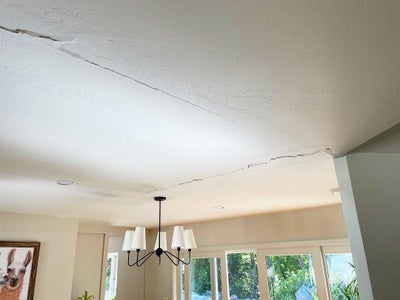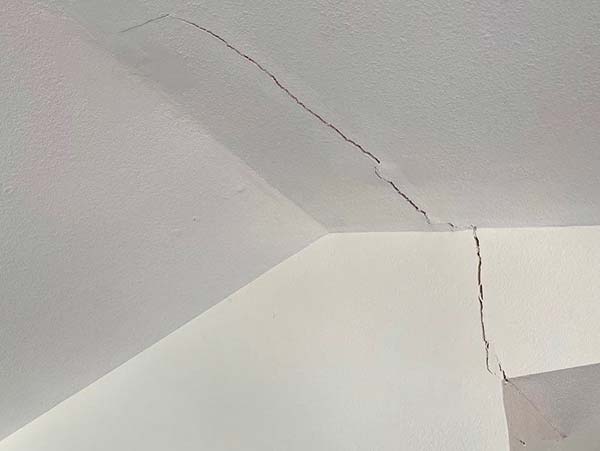How To Fix Ceiling Cracks
Table of Contents
1. First, Some Good News – Not All Ceiling Cracks Indicate A Serious Structural Problem
2. Structural Vs. Non-Structural Ceiling Cracks
3. Which Ceiling Cracks Are The Most Serious?
4. What Causes Ceiling Cracks?
5. How To Fix Minor, Non-Structural Ceiling Cracks
6. How To Fix Structural Ceiling Cracks
7. How To Help Prevent Structural Ceiling Cracks
Are you a homeowner searching for information on how to fix ceiling cracks? If so, you’ve landed on the right page because that’s what we’re going to talk about in this article. We’ll talk about the causes of ceiling cracks, how to fix ceiling cracks, the difference between ceiling cracks that are just ugly and those that indicate a serious foundation problem, and more.
First, Some Good News – Not All Ceiling Cracks Indicate A Serious Structural Problem
Yes, ceiling cracks can be alarming. However, they don’t always indicate a serious structural problem. Some ceiling cracks are just ugly and can be easily fixed with patching and repainting. However, it’s important to recognize when a ceiling crack indicates something more serious. Factors such as the crack’s size and any accompanying symptoms like sagging need to be taken into account. If you’re unsure about the severity of a ceiling crack, contact a foundation repair professional and ask for an evaluation.

Structural Vs. Non-Structural Ceiling Cracks
Ceiling cracks are pretty common. However, not all ceiling cracks are created equal. Some ceiling cracks are structural, while others are considered non-structural.
Structural Ceiling Cracks
Structural cracks, which can be identified by their large size, indicate serious problems with the building’s foundation.


Non-Structural Ceiling Cracks
Non-structural cracks are typically smaller. They’re usually caused by changes in temperature and humidity, paint build-up over the years, etc.


While both types of cracks can be unsightly, it’s essential to understand the difference between the two and address any structural issues quickly to ensure the safety of your home and family.
When in doubt about a ceiling crack, ask a pro.
Which Ceiling Cracks Are The Most Serious?
Ceiling cracks can cause concern, but not all are equally serious. Some cracks are cosmetic issues caused by normal wear and tear, while others may indicate severe structural damage. The most serious types of cracks are the following:
- Cracks that go across the ceiling and down a wall. One continuous crack, in other words.
- Ceiling cracks accompanied by bowing. Is there something heavy on the floor above the bowed ceiling? There also might be a problem with the joists or trusses in the attic.
- A series of small ceiling cracks. Multiple cracks next to each other, even small ones, can indicate foundation damage.
If you see any of the above – or anything else that strikes you as suspicious – contact a foundation repair contractor right away and ask for an evaluation. It’s essential to have the underlying problem that caused the structural ceiling cracks repaired as soon as possible by a qualified professional to ensure the safety of your home and prevent any further damage.
Also, if you see a ceiling crack, look around for other signs of foundation trouble. Examples include uneven floors, doors and windows that don’t open and close properly, cracks in walls and floors, stair-step cracks in brick and masonry, etc.
For more information, see Are Ceiling Cracks Serious? Causes Of Ceiling Cracks And When To Worry.
What Causes Ceiling Cracks?
There are various reasons why ceiling cracks may occur, including natural settling of the house over time, temperature changes, moisture, paint build-up, differential foundation settlement, something heavy on the floor above the cracked ceiling, and water infiltration (leaking roof, for example).
If a crack is small, it may not be cause for concern. However, a large crack that continues to expand could be a sign of a more serious issue.
It is important to identify the root cause of the ceiling crack and address it promptly to prevent further damage to your home. A professional foundation repair contractor can help determine the cause and provide a solution to ensure your ceiling remains secure and stable.
How To Fix Minor, Non-Structural Ceiling Cracks
Non-structural ceiling cracks can be easily fixed with just a few steps. First, you’ll want to assess the crack to make sure it’s a minor, non-structural crack. If it is, you can move on to fixing it:
- Start by cleaning the area around the crack to remove any loose debris, dust, drywall compound, or drywall tape.
- Next, use a putty knife to apply spackle or joint compound to the crack, covering the entire area.
- Once dry, sand the area with fine-grit sandpaper, prime, and paint to match the surrounding ceiling.
With these simple steps, your ceiling will look as good as new in no time, provided the ceiling crack is non-structural.
How To Fix Structural Ceiling Cracks
Structural ceiling cracks are often caused by differential settlement. As we’ve just noted, this is when a foundation settles into the ground unevenly. Differential settlement puts stress on a foundation and will cause serious structural damage if it isn’t immediately repaired. The graphic below illustrates differential settlement and how it differs from uniform settlement, which isn’t a problem.
Structural ceiling cracks should only be repaired by an experienced foundation repair contractor. Only they have the knowledge and equipment necessary to fix the underlying problem that caused the ceiling crack.
How To Help Prevent Structural Ceiling Cracks
Since most structural ceiling cracks are caused by differential settlement, the best way to help prevent them is to take preventative measures that will protect your home’s foundation from differential settlement. The most effective way to do this is to control groundwater around the foundation to prevent excess moisture from building up in the soil since this is the cause of most foundation problems. Here are some ways to do that:
- Regrade your yard, if necessary, so it slopes away from the foundation. This prevents groundwater from draining toward the foundation.
- Use downspout extensions to carry water several feet away from the foundation being released.
- Clean your gutters regularly to ensure runoff stays in them and goes where it should.
- Consider relocating any water-hungry vegetation planted next to your house.
- Install a drain tile system. This highly effective waterproofing system works by redirecting water away from the foundation.
If you’re concerned about one or more ceiling cracks in your home, contact Bay Area Underpinning today to schedule a foundation evaluation. We serve all of Northern California.
More Resources
Publish Date:
Last Modified Date:

Our Locations
2333 Courage Dr. Suite C
Fairfield, CA 94533
1161 N Fair Oaks Ave
Sunnyvale, CA 94089



